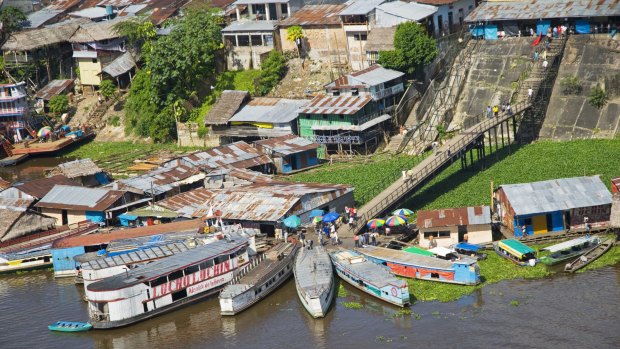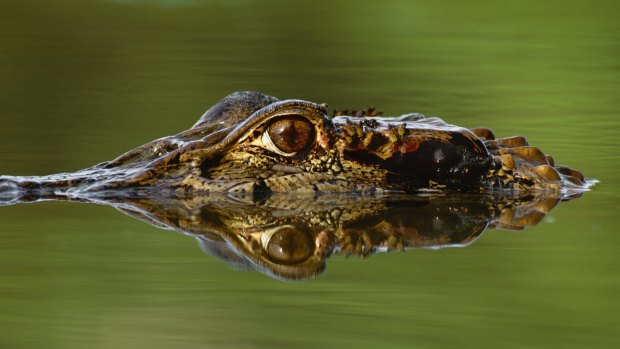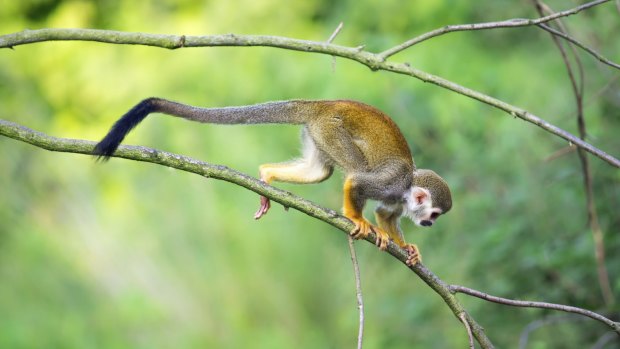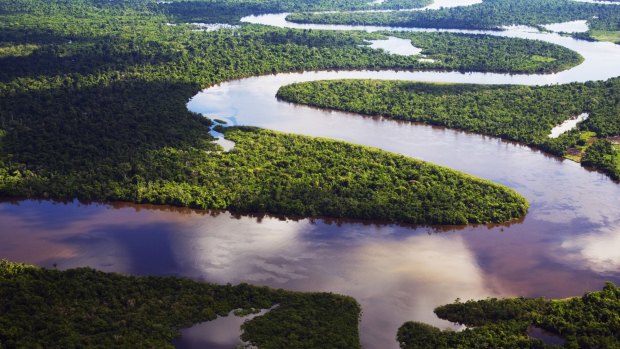This was published 7 years ago
Cruising the Amazon: The one must-do South American experience

Peru, Amazon, Amazon River, Iquitos. Aerial view of the port, harbour and settlements of Iquitos, the principle city of the Upper Amazon Basin.Credit: Paul Harris
"In the movies, piranhas eat people," says Chino, our guide, threading a lump of beef tenderloin onto a fishing hook. "But in the Amazon," he grins, "people eat piranhas."
With that he drops the hook over the side of the boat, leaving it dangling in the swirling waters of the Rio Dorado for a few seconds before giving the line a swift tug and hauling a flapping, snapping piranha into the boat. Just like that. The fish lies there in the hull, gills heaving, razor-sharp teeth grinding, as the rest of us stare and quietly consider the contents of the river below us. How many of those things are down there? Suddenly hands and arms are drawn inside the boat.
See also: South America - a first timer's guide to the ultimate destination

Black caiman, Melanosuchus niger, Manu National Park, PeruCredit: Mint Images - Frans Lanting
The thing is though, Chino's right. Piranhas, those famously flesh-eating Amazonian movie stars, don't really eat people out here in the Pacaya Samiria Reserve, deep in north-eastern Peru.
They're much more likely to be the victims, as they are today, being hauled one by one with frightening regularity into this little boat floating on a river in the middle of the jungle.
There's so much to learn in the Amazon. So much to learn on this huge flood plain, a reserve the same size as Belgium, a patch of dense forest and rivers that for half of the year is almost completely submerged. You discover such an amazing amount about this part of the world in just a short few days.

Common squirrel monkey (Saimiri sciureus) walking on a tree branch
There are fish out here that have evolved to be able to leap out of the water to catch insects. There are prehistoric river creatures that can breathe on land. There are manatees and pink river dolphins in the swirling, murky rivers; monkeys that roam the treetops. There's so much life, both animal and human, at the beginning of the mighty Amazon River. And we're here to learn.
See also: Unlock the secrets of Machu Picchu
A WILD WORLD

Peru, Amazon, Amazon River. Bends in the Nanay River, a Tributary of the Amazon River.Credit: Paul Harris
This huge area of forest, riven with sparkling waterways, seems to stretch on forever as you fly into the town of Iquitos, the plane soaring over the Andes Mountains before descending into the lowlands of the Amazon in Peru's north-east.
Much of Iquitos is submerged during the rainy season – this is a wild town full of people who've learned to dwell under difficult conditions.
It certainly looks wild.
Just outside the airport there's a sign advertising "Torneo de Gallos": cockfighting. The traffic is a swarm of motorbikes and rickshaws, each with a rig of heavy tarpaulin ready to protect the riders from the area's torrential rains.
Iquitos is like an island, with no road access to the rest of the country. You get the feeling it functions under laws of its own. Soon, however, you're whipped out of Iquitos and onto the road towards Nauta, the port town on the banks of the Ucayali River, just upstream from the beginning of the Amazon.
That's where travellers board the Delfin II, a luxury riverboat that prowls the Ucayali and Pacaya Rivers, treating guests to a wild experience that ends each day with a return to plush private rooms and fine-dining meals.
Night is falling as my group boards and the Delfin pulls away from the wharf, turning upriver towards the Pacaya Samiria Reserve. Our first sight of the local wildlife, it turns out, is on a plate. Tonight we're dining on doncella, a river fish much loved around these parts as a culinary staple.
It's prepared, as all of the meals on this five-day cruise will be, as part of a sizeable Peruvian feast that makes use of plenty of local Amazonian ingredients, as well as those from further away in the Andes and on the coast. Tonight, however, there are no piranhas.
THE GREAT UNKNOWN
It's amazing to just sit and think about what's out there. To the untrained eye it's not much: dense forest, clear skies, murky waters. But out there in Pacaya Samiria, out there just past the glass of the huge picture window in my suite, there are 102 different species of mammals roaming the trees and the land; there are 449 types of birds in the air; there are 58 amphibian species and 256 types of fish in the river below.
Sometimes you can spot jaguars out here, if you're extremely lucky. Even more rarely, you can see marvels such as the arowana, a fish that can leap two metres out of the water to snaffle insects that have been resting on tree branches.
And you'll probably never spot paiche, these huge, two-metre-long river fish that have evolved to cope with the dry season, with a lung that allows them to breathe normal air.
What you do see out here is a tiny snapshot of jungle life, a brief glimpse of the world that lies within. You see birds, flocks of hundreds. You see the pink flash of river dolphins briefly surfacing near the boat. And you see monkeys. Of course you see monkeys: squirrel monkeys, owl monkeys and howler monkeys that peer with their beady eyes from high above.
On our first morning in the jungle, we're exploring those monkeys' world by kayak, paddling around a lagoon that sits adjacent to the Ucayali, listening to the sound of birdsong, watching for flashes of colour as kingfishers, egrets and herons flit past. We can hear noises in the trees, see leaves rustle, but the jungle is slow to give up its secrets.
By afternoon we're out in one of the three motorised skiffs that the Delfin crew uses to take clients up into the tributaries that feed the Ucayali River, deep into the heart of the reserve. We spot the tiny painted faces of owl monkeys huddled high in the canopy.
We see a caiman, a prehistoric reptile that looks a lot like a miniature crocodile, eyeing us from the shallows. But still, you feel there's so much more here to discover.
It pays to be up early in the jungle, to awake at the same time as the creatures that surround you. By day three we're rising before the sun, clambering into the skiffs and skimming over the water towards the riverbank as the birds begin to call and undergrowth begins to rustle. There are hawks out hunting this time of morning; herons are stalking the shallows.
We alight from the boat and trek across the jungle floor, exploring a damp, humid environment that is submerged under a good metre or two of water for half of the year. Squirrel monkeys rustle the branches high above.
Hundreds of hairy caterpillars writhe and squirm on a tree trunk. Chino, our guide, gives us a crash course in natural Amazonian medicine, pointing out the plants that can cure you, as well as the plants that will do the opposite. It's fascinating, and a little unnerving.
After some breakfast back on the Delfin II – huge, delicious and served with a smile – we head out in the skiffs again, this time up the Rio Dorado, another tributary that feeds the Ucayali. There we spot a local village, the houses on stilts to cope with the yearly floods, before pulling into an inlet so Chino can bait up a few hooks and go piranha fishing.
There's six of us on board and within 15 minutes or so we've all caught several of these vicious little fish, each of us carefully unhooking them and throwing them back into the river. Far above, vultures circle in the air. They must have seen this show before.
NIGHT MOVES
Our days on board the Delfin II are busy, despite the heat and humidity of the jungle always seeming to encourage a mid-afternoon nap in those huge air-conditioned suites with their wrap-around windows. But there's so much more to do than just lie around. There are usually two excursions a day on the skiffs, journeying up smaller rivers to spot monkeys in the treetops and birdlife flitting below. On day three we even make a third outing, late in the evening, when the moon shines bright and the nocturnal creatures of the forest can be spotted by the glow of their eyes in the light of our guides' torches.
In between all the exploration there are three hearty meals each day served on board that showcase the best in Peruvian cuisine – everything from ceviche and causa to steaks and Amazonian fruits.
There are also informal lectures from the guides on the surrounding wildlife, and time to spend on the open upper deck of the boat, lounging with a pisco sour and watching the never-ending jungle roll by.
By day four that jungle has begun to change, becoming sparser as we turn into the Pacaya River, allowing glimpses of animals that have previously gone unseen. We spot jabiru storks in the tree branches, the small red splashes of colour on their necks lighting the jungle.
We see huge flocks of cormorants soaring across the river's surface, their wingtips carving lines in the mirror-still water. Squirrel monkeys leap about in the trees.
Eventually, we come to a huge lagoon where the guides shut off the engines and let the skiffs glide to a halt. It's perfectly still; perfectly quiet. We can swim here, Chino says. It's too deep for caiman and there are no piranhas in this part of the river. Just the pink river dolphins that we've been spotting from the boat for the last few days. So we dive into the cool water, enjoying the feeling of swimming freely in one of the most remote and beautiful places on Earth.
And then, of course, we jump back in the skiffs, motor back towards the river mouth and immediately spot the beady eyes of a familiar reptile on the bank.
"I thought you said there were no caiman around here?" I say to Chino.
He just grins. "OK, maybe some. But definitely no piranhas."
TRIP NOTES
MORE INFORMATION
GETTING THERE
LATAM Airlines offers seven one-stop flights per week from Sydney to Santiago, Chile, aboard 787 Dreamliner jets. There are then connections on LATAM to Lima and onwards to Iquitos. Call 1800 126 038, or see latam.com.
CRUISING THERE
The Delfin II offers four- and five-day Amazon cruises that depart from Nauta in Peru, with transfers included from Iquitos. Passengers have a choice of master suites with 180-degree windows, or cabin suites with large picture windows. Cruises start from $US3000 per person twin share and include full hotel service, three meals a day, non-alcoholic drinks and at least two skiff excursions a day accompanied by an expert guide. For bookings call Chimu Adventures on 1300 784 286 or go to the website above.
TOURING THERE
There has been sporadic transmission of the zika virus in Peru and the Australian government's Smart Traveller website currently advises travellers to "exercise a high degree of caution". All visitors should take extra precautions to guard against mosquito bites, and pregnant women are advised to postpone their travel plans or consult their doctor. See smartraveller.gov.au
Ben Groundwater was a guest of Chimu Adventures, Rutas and LATAM Airlines
FIVE MORE WILD PERU EXPERIENCES
REFUGIO AMAZONAS
This wilderness lodge is set deep in the Peruvian Amazon, a three-hour boat ride up the Tambopata River from Puerto Maldonado. It provides a few of the creature comforts as well as the chance to explore, by day and by night, the surrounding jungle. See perunature.com
SALKANTAY TRAIL
A great alternative to the standard Inca Trail route is the Salkantay Trail, a spectacular and yet almost tourist-free path leading through the Andes near Machu Picchu. Remote it might be but there are also luxury lodges dotted along the trail in which hikers can rest weary legs. See mountainlodgesofperu.com
MANU WILDLIFE CENTER
There are an incredible 575 species of birds that can be spotted in the treetops near the Manu Wildlife Center, on the Madre do Dios River. Plenty of monkeys as well. The centre is a one-and-a-half-day bus ride from Cusco, a journey that's an adventure in itself. See manuexpeditions.com
INKATERRA RESERVA AMAZONICA
Just because you're in the jungle, doesn't mean you have to be roughing it. This lodge is run by one of Peru's premier luxury hotel brands, which means that along with all of that wildlife you also get bathrobes, organic toiletries, and access to a day spa. See inkaterra.com
CHAPARRI ECO-LODGE
Up in Peru's north-west lies Reserva Chaparri, an area of dry-forest with a completely different ecosystem to those you'll find in the Amazon or the Andes. It's a much more stripped back experience up here, with simple rooms meant to replicate the way the local population lives. See chaparrilodge.com
FIVE AMAZING AMAZON FACTS
THE RIVER MAY BE THE WORLD'S LONGEST It's definitely the world's largest, carrying a phenomenal one-fifth of the world's entire freshwater flow. However, there are scientists who also claim the Amazon River is the world's longest: if the system of islands around the river's mouth is counted as being part of the river, then it would add 350km to its length, giving it a total of 6750km – about 150km longer than the Nile.
THE RAINFOREST SPANS NINE COUNTRIES The Amazon covers 5.5 million square kilometres – more than twice the size of Western Australia – and stretches across Brazil, Bolivia, Peru, Ecuador, Colombia, Venezuela, Guyana, Suriname and French Guiana. Brazil has the biggest chunk, with about 60 per cent of the forest residing within its borders.
IT'S A HAVEN FOR WILDLIFE Across the entire Amazon rainforest system there are about 2.5 million insect species, 2200 species of fish, 1294 bird species, 427 mammals, 428 amphibians and 378 reptiles. And those are just the ones that have been scientifically classified.
...AND FOR PLANTS There's more than 40,000 plant species across the same rainforest system. One square kilometre of Amazon rainforest can contain more than 90,000 tonnes of living plants.
THERE ARE PLENTY OF HUMAN INHABITANTS It's thought that around the year 1500 there were more than 5 million people living in the Amazon. That number has shrunk now to less than 200,000; however, there are still between 400 and 500 tribes who call the rainforest their home and it's believed that up to 50 of those have never had contact with the outside world.
Sign up for the Traveller Deals newsletter
Get exclusive travel deals delivered straight to your inbox. Sign up now.